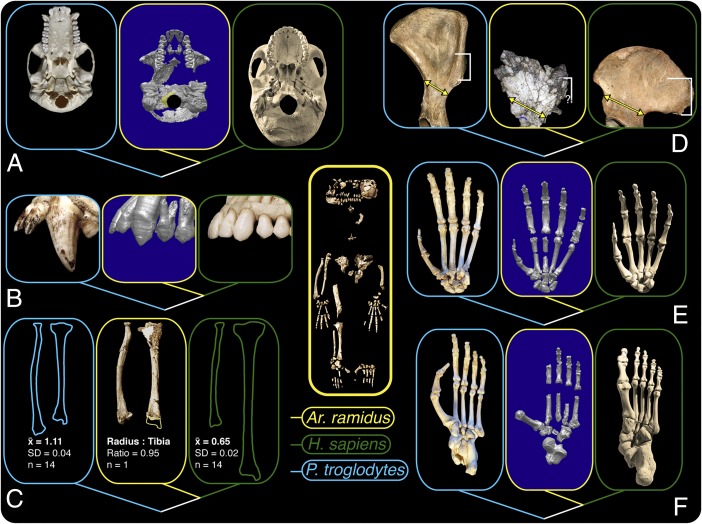Fig. 1.
Evolution in different directions. Pan troglodytes (left boxes); Ar. ramidus (center boxes); H. sapiens (right boxes). Micro-CT renders on blue backgrounds. Ar. ramidus nests in the hominid clade based on uniquely derived character complexes shared exclusively with Australopithecus and Homo. In the skull (A), chimpanzees combine a primitively long posterior, and derived elongate anterior basicranium; hominids share derived shortened bases. In the dentition (B), hominids lost the primitive functional honing complex of fossil and modern great apes based on a projecting male canine (male Ar. ramidus dentition, ARA-VP-1/300, shown; there is no honing). In limb proportions (C), Ar. ramidus is primitive relative to the derived elongated arm of the chimpanzee and the lengthened leg of the human. Radius and tibia outlines adjusted to mean lengths; ARA-VP-6/500 tibia’s missing distal end is conservatively restored per SI Text, Note 2. In the pelvis (D), hominids share broader, lower iliac blades (yellow arrows; white brackets show the superior and inferior extent of the sacrum’s articular surface; short blue line on fossil indicates superior margin of hip joint). Note the low position of the sacral joint in hominids. The chimpanzee hand (E) bears elongate metacarpals and stiffening for climbing and suspension. Hominids primitively retain short metacarpals, whereas humans have shortened phalanges. The Ar. ramidus foot (F) shows a primitive midfoot that had not evolved into the shortened flexible structure of living apes; neither had it evolved into a modern human-like foot that functions both as a stiffened lever and a compliant shock absorber.

